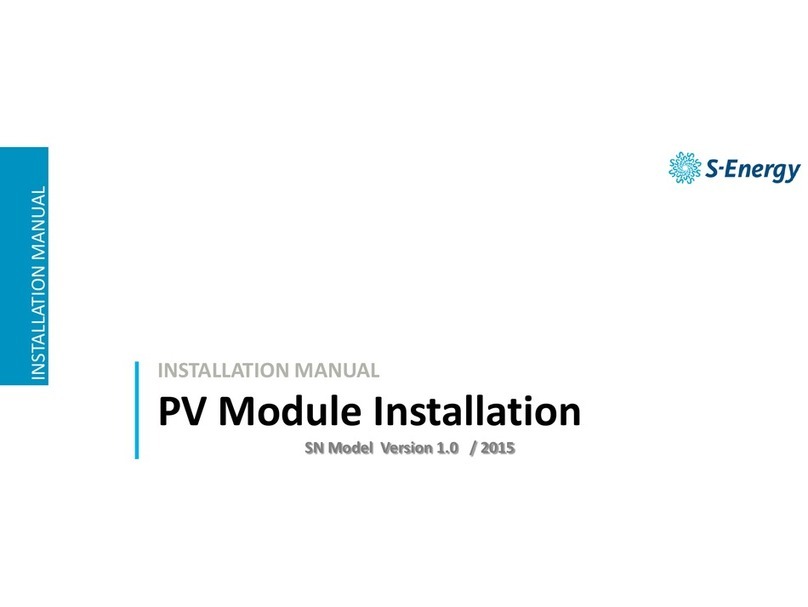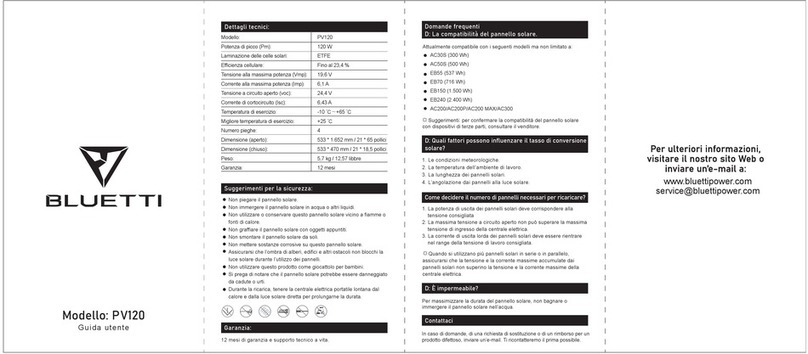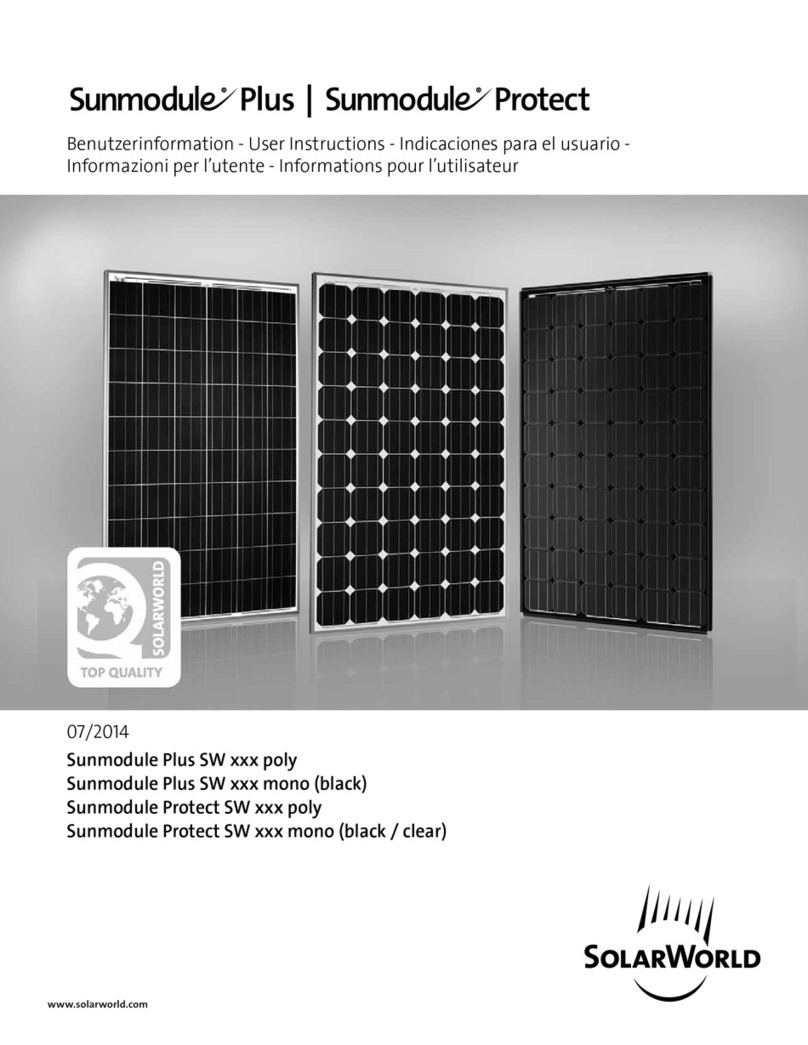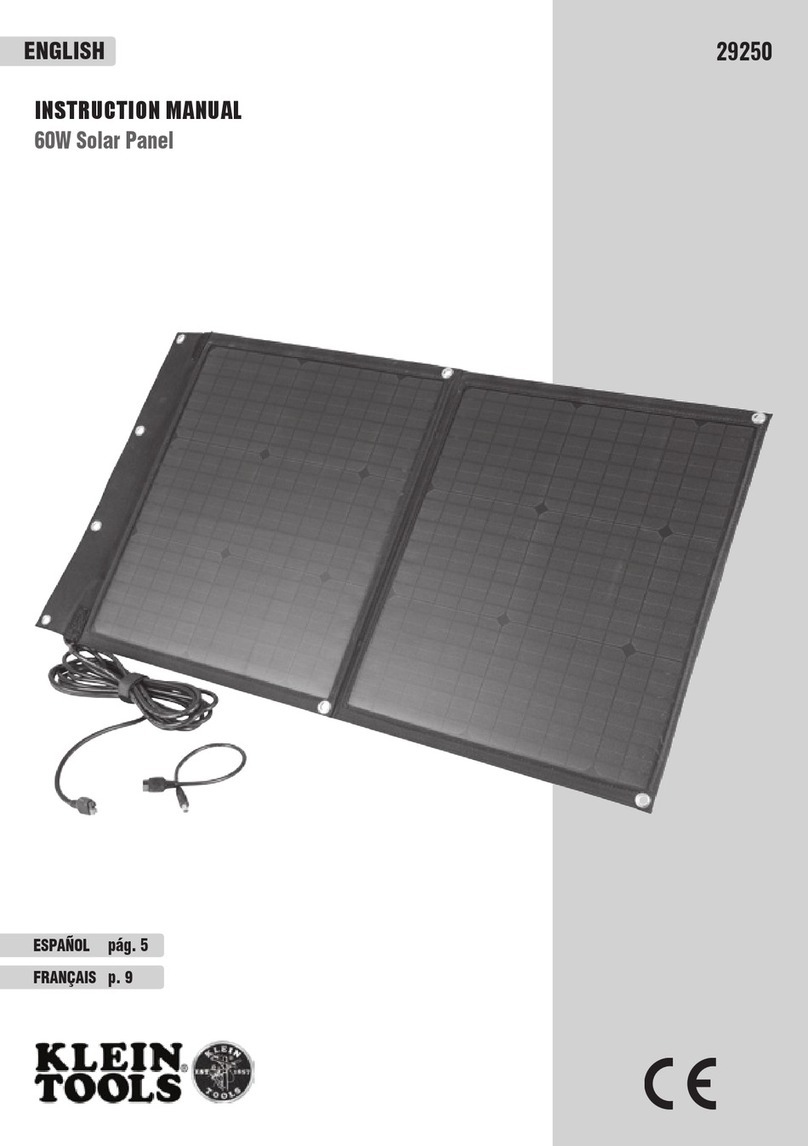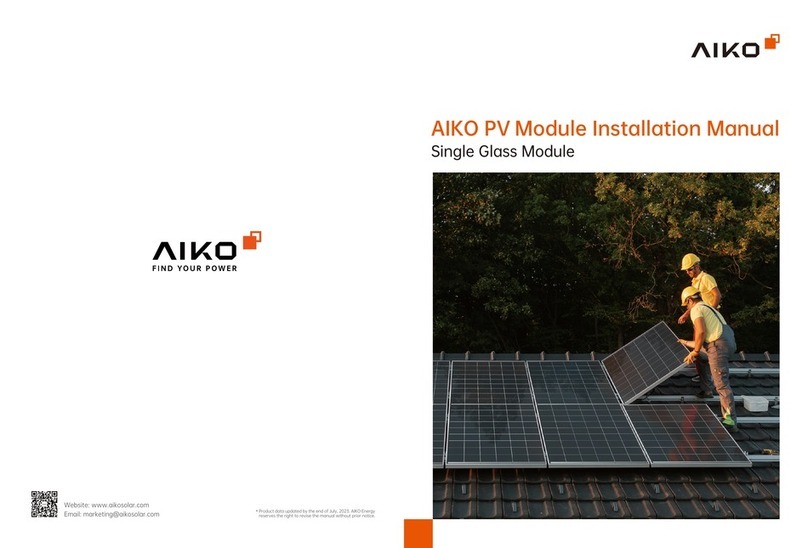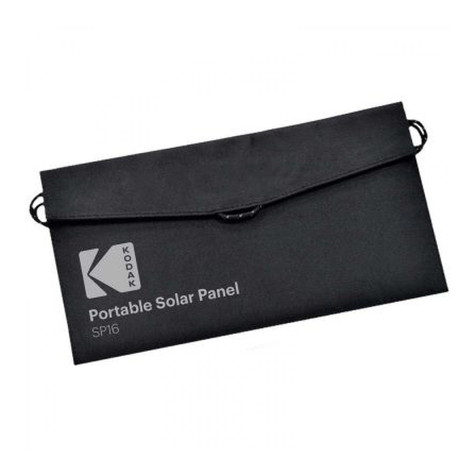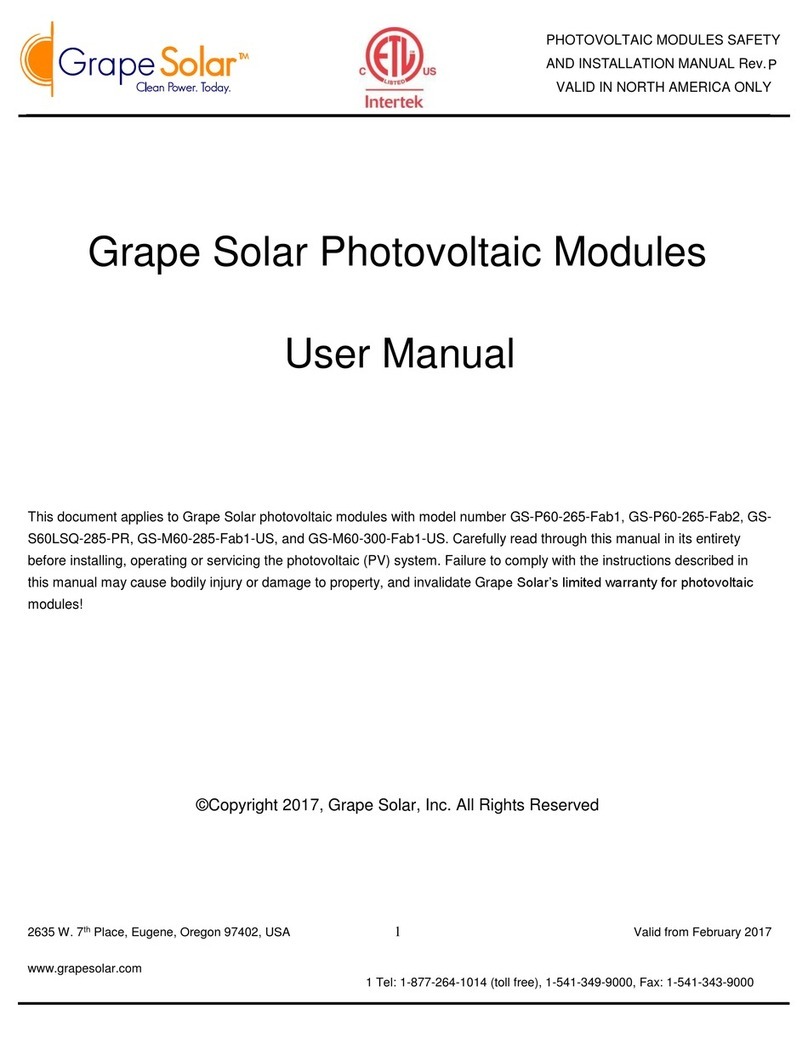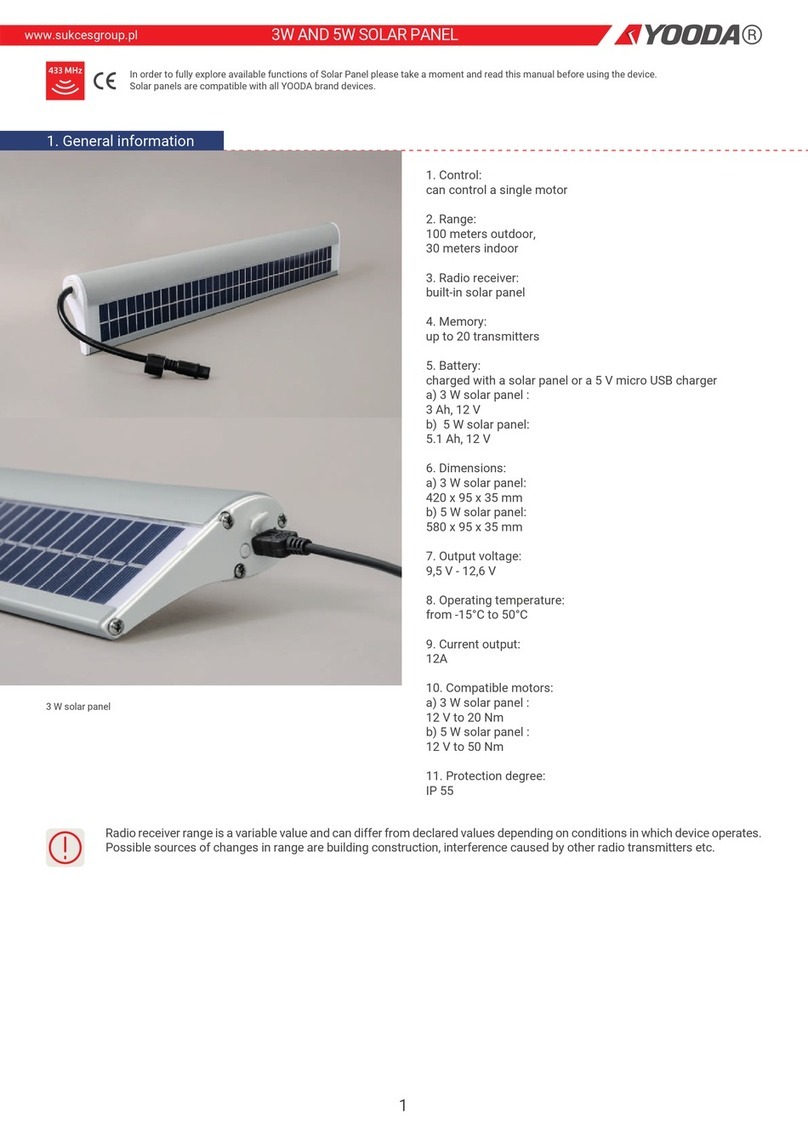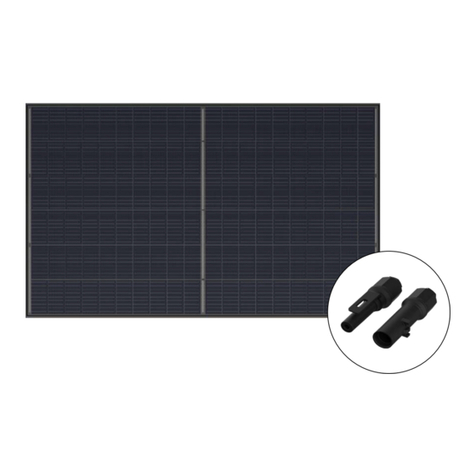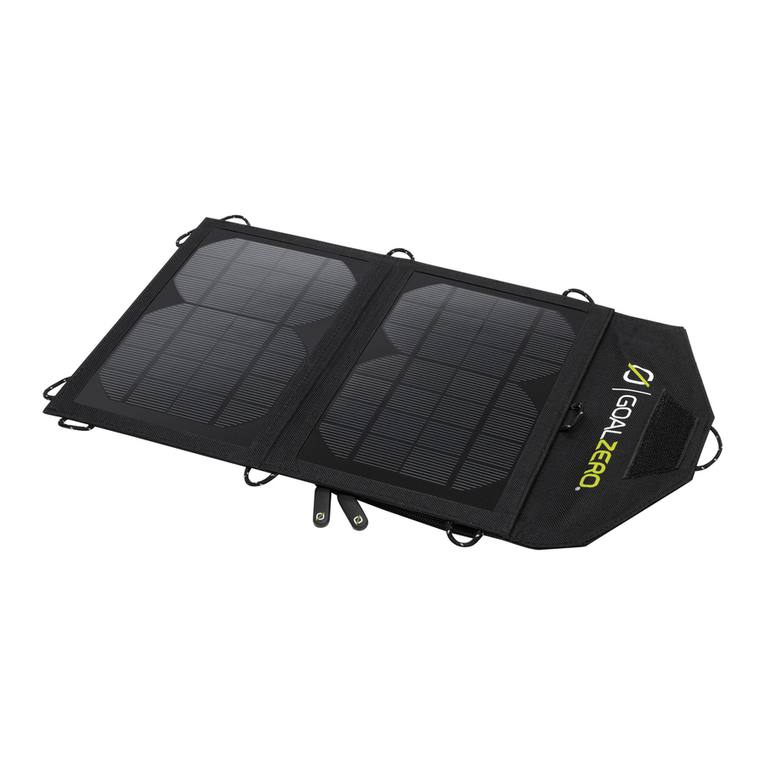Senergy SC Series User manual

EN ver 1.0_2019
Copyright 2019. S-Energy all rights reserved.
INSTALLATION
GUIDE
SCSERIES 1,000V
ENHANCED PID
ENVIRONMENT RESISTANCE
MECHANICAL LOAD 5,400 Pa
HAIL IMPACT TEST 25 m/s

S-Energy PV Module Installation Manual
0.0 2019.09.23 1st edition
Rev history

S-Energy PV Module Installation Manual
Before Use
1. Accessories
2. Safety Precautions
3. Environmental Considerations
4. Caution before Installation
5. Caution when Installed
6. Electrical Installation
7. Grounding Method
8. Mechanical Installation
9. Maintenance
10. Cleaning Instructions
11. Detailed Module Specification
12. Installation Instructions
01
01
02
03
04
04
05
06
07
09
09
10
11
Chapter Page No.
INDEX

01S-Energy PV Module Installation Manual
1)
2)
3)
4)
5)
6)
This installation manual (hereinafter referred to as "this manual") includes installation and maintenance methods,
and important safety instructions for the PV module(hereinafter referred to as "PV module") produced and sold by
S-Energy. Please store this manual in the visible area for future reference after installation.
Any troubles caused by failure to comply with these instruction during the installation, use, operation, maintenance of
the module may be excluded for warranty.
All installation, operation shall be based on this manual, and the actual installation, use, operation and maintenance
should be performed by qualified personnel with electrical license.
For the detailed quality warranty policy of the product, please refer the quality assurance provided by S-Energy Co., Ltd..
When the contents of this manual conflict with the quality assurance, the quality assurance takes precedence.
In order to provide better service, the information included in this manual is subject to change without prior notice.
The name of each part of solar module is presented as 'Fig. 1'.
When requesting maintenance, please inform malfunction part and its performing status including
the name of each part by referencing the Below figure.
Accessories1.
Before Use
l
< Fig. 1 >
Junction Box

02
S-Energy PV Module Installation Manual
Safety Precautions2.
CAUTION
CAUTION RECOMMENDATION
Store a module in an indoor warehouse before
installing.
The utmost care is required for preventing corrosion/
contamination/deterioration due to mishandling
when you load/outdoor load/installation.
Working on a PV system requires following all
applicable local codes and wearing protective
equipment, and must be performed by appropriately
qualified and authorized personnel only.
Always wear protective equipment while working
with PV modules.
Do not place heavy objects on the module.
Stepping on or allowing objects to fall on the module
may damage certain parts of the product and slow
down the performance significantly, or causes risks to
the whole system.
Install when the weather is clear.
Do not install when snowy, rainy, and windy days.
Do not install where water remains on the ground.
All surfaces and corners are fragile, so touch only
the frame areas when moving/installing. And do not
allow direct shock or hit to the module.
PV module should be installed by a two person team.
Be careful when handling because the shock may
cause damage or low performance.
These “Safety Precautions” should be thoroughly understood before installing.
※ PV module installation should be performed by qualified person only.
Do not step, stand or sit on the
modules to install and clean.
DANGER
CAUTION
When connecting with '+', '-' in module, the cable shall be equipped with direct current, and shall not connect or
disconnect with module when electricity flows. If an abnormal or old electrode is connected, you may get injured by
sparks arising from direct current.

03S-Energy PV Module Installation Manual
ENVIRONMENTAL CONSIDERATIONS
1)
2)
The shading of the front surface is the main cause of hot spot or
performance reduction of power generation.
The ground should have well drained soil.
CAUTION CAUTION
Do not scratch by a sharp tool on the module
frame and surface. Abrasion of the coated
surface may lead to oxidize frames or reduce
their strength.The scratch of the surface may
be the main cause of the module output
degradation and decrease in strength.
The front surface of the module shall not be
exposed to sunlight artificially.
[It can cause performance degradation due
to solar cell degradation.]
Do not touch or give shocks to the Junction
box as well as front and rear surface of
module, and do not remove the label.
Prohibited taking J-box cable when you
handle the modules.
[Resulting in electrical disconnection.]
Prohibited connecting diagonally Male &
Female when electrical [connector] connecting.
[Resulting in poor contact.]
Cable outer diameter of 8mm/ Recommended
by more than 48mm radius of curvature.
[Cable minimum bend radius is more than
6 times the cable diameter when wiring.]
Cable wiring securely fixed to prevent shaking
in the wind with cable tie.
[However, consider summer/winter thermal
expansion/contraction.]
Do not touch with wet hands or equipment,
which can result in electric shock.
Environmental Considerations3.

04
S-Energy PV Module Installation Manual
1)
2)
3)
4)
5)
6)
Please make sure that installed module wire distribution is correct, and insulation and waterproof performance of
connect part is suitably installed.
Check if there are any scratches on the frame and front surface of the glass.
[The scratch may lead oxidation and reduce the strength.]
Regularly clean the module with water, and if the module is not cleaned with water, request to the manufacturer.
[Regular cleaning can significantly improve the output capacity.]
The front surface of glass is specially treated, so do not apply any abrasive cleaning product or chemicals.
Periodic inspection should be performed only by qualified personnel with protective equipment.
To avoid shade by the vegetation environment, regular weeding is needed.
Please read this instruction before installing PV module.
Caution before Installation
Caution when Installed
4.
5.
1)
2)
3)
4)
5)
6)
7)
8)
9)
10)
11)
12)
13)
14)
15)
16)
17)
18)
The installation of PV module should be performed by qualified personnel only.
When installing PV module, you should wear protective equipment. [electric shock or falling accident risk.]
When installing PV module, do not step up onto the PV module or place the object on it.
After installation, qualified person shall check whether it operates properly or not.
Disassembling or replacing of the PV module part is not allowed without permission by manufacturer, and if you disassemble
or replace anything, please inform the PV module manufacturer.
When disassembling or replacing the part with manufacture’s permission, it should be performed by qualified person only,
and use the certified accessories.
All installation work most be done to meet the local applicable standards, such as the recent National Electrical Code or
National Electrical Standards.
When the PV module is damaged or stopped, anyone, even who has useful knowledge for the PV module, should not
approach to the PV module. Touch or approach may cause serious injury, in which case manufacturer is not responsible for
the damage therefrom.
PV module’s orientation shall be at equator direction, and be installed at the same angle as the latitude of the installation
location for the optimal generation performance. If it is installed at a different angle or direction, it may adversely affect an annual
generation capacity. In case of horizontal installation, S-Energy recommends regular cleaning to remove dust on the surface.
PV module generates the voltage even without load connection. So, be careful for sparks especially when assembling /
disassembling PV module.
PV module is intended to be installed on the ground or building.
If you need to install on the vehicle(car, train, etc.) or ship, please request special modules.
Snow, water, dust, or other foreign substance on the surface may increase reflection of the light and eventually reduce the
PV module’s output. [Regular cleaning of module surface can improve performance.]
Standard specifications was measured at STC rating conditions, temperatures can get very effective in increasing power
generation is low.
Before installation, modules should be stored under packing condition.
Irrespective of module connection, contacting current carrying part may cause a burn or fatal electrical shock from sparks.
The shading of the front surface of the module can cause the module degradation by fire or reduce its lifecycle.
When working with the PV module wire, connect the wire with a hanger to avoid contact on the roof or ground.
Potential Induced Degradation [PID] may be caused by ambient high temperature, humidity, and high system voltage. S-
Energy's PV module equipped with Enhanced PID module can endure these degradation, but along term exposure may
also cause PID. To competely prevent PID, trans inverter and Nagative GND should be connected to the (-) GND with the
module frame.
Do not use or install broken modules; Failure to comply may result in fire, electric shock, and injury.
19)

05S-Energy PV Module Installation Manual
A. Series Wiring
< SERIES WIRING [VOLTAGE ADDED] >
1)
2)
3)
4)
5)
6)
7)
8)
9)
10)
11)
Electrical risks must be prevented during installation, distribution, generation, and maintenance of PV module.
During installation of PV module, system voltage should not exceed. [IEC 1000V]
When installing the system, use same rate of model. [If you use a electrically and physically different type of module, output
capacity or system performance may be reduced due to fire.]
When wiring, you should connect polarity appropriately, and if not, it can cause abnormal generation performance and PV
module degradation by fire.
For the reverse current value, refer the Fuse rating value specified in '11. Detailed module specification'. If exceed its value
, connect the rated overcurrent protective device(permitted by local regulation) to the module string in series wiring.
Junction box is in the rear surface of the module. This box is an important device for the module generation, and never
unpack it in any circumstance in the field. [Once the junction box is opened, warranty will be invalidated.]
If the PV module have any electrical problem, you should inspect the module according to the warranty term provided by
S-Energy, and return it to S-Energy for repair and replacement.
The fire rating of this module is valid only when mounted in the manner specified in the mechanical mounting instructions.
The module is considered to be in compliance with UL 1703 only when the module in mounted in the manner specified by
the mounting instructions below.
A module with exposed conductive parts is considered to be in compliance with UL 1703 only when is electrically grounded
in accordance with the instructions presented below and the requirements of the National Electrical Code.
Any module without a frame (laminate) shall not be considered to comply with the requirements of UL 1703 unless the
module with hardware that has been tested and evaluated with the module under this standard or by a field inspection
certifying that the installed module complies with the requirements of UL 1703.
In normal conditions, PV modules may produce larger current and/or voltage than reported in the standard test conditions.
Therefore, when voltage evaluations for components, capacity of conductors, size of fuses, and size of control systems connected
to the module output are determined, multiply the values of short- circuit current (Isc) and open-circuit voltage (Voc) that are
marked in SN series modules by the NEC, 1.25 (Source: American National Electrical Code)
CAUTION
B. Parallel Wiring
< PARALLEL WIRING [CURRENT ADDED] >
·
·
·
·
·
·
Wires may be connected in parallel to generate the required
current output.
Even when wires are connected in parallel, the intensity of voltage
in inverter should be considered.
Before connected to other modules, all modules should be wired
with a fuse. For the number of additional fuses and maximum
number of module should refer and follow the related local
regulations.
Wires may be connected in series to generate the required
voltage output.
Series wiring should be configured at the same rate. (current)
Only for UL 1703, When wires are connected in series, the
maximum voltage should be under 800Vdc that is 80% of
system Voltage 1000Vdc
· Material :
All the wire for the PV module connection should be configured with PV cable only. [Cable for PV : double insulation, UV
resistance, temperature resistant for more than minimum 90℃.] Use copper wire for all wiring.
· Module configuration[Series wiring]
[{(Min Temp
℃
– 25
℃
) x (Voc x -Temperature coefficient of Voc)} + Voc] x Panels per string = Maximum system Voltage
To guarantee the maximum voltage limitation condition, ensure the general temperature condition according to the National
Electric Code (690.7)
· Diameter:
At least larger than minimum 12AWG. [4mm2]
[wiring diameter should confirm the local regulation, and S-Energy Co., Ltd. recommends the customer use wires with a diameter
larger than the above number at minimum.]
Electrical Installation6.

06
S-Energy PV Module Installation Manual
For preventing electric shock and fire, the frame of PV module shall be grounded properly.
Grounding Method7.
[Please be sure to remove a coated portion when grounding, because the PV module aluminum frame is coated with anodizing.]
Where common grounding hardware (nuts, bolts, star washers, spilt-ring lockwashers, flat washers and the like) is used
to attach a listed grounding/bonding device, the attachment must be made in conformance with the grounding device
manufacturer’s instructions.
Common hardware items such as nuts, bolts, star, washers, lock washers and the like have not been evaluated for electrical
conductivity or for use as grounding devices and should be used only for maintaining mechanical connections and holding
electrical grounding devices in the proper position for electrical conductivity. Such devices, where supplied with the module
and evaluated through the requirements in UL 1703, may be used for grounding connections in accordance with the
instructions provided with the module.
·
·
The grounding clip assembly consists of aslider, base, and self–captivating thread–cutting screw or
1. Using aNo. 21 drill bit, drill a(4.09–mm [.161–in.] diameter) hole in the frame.
2. Place the grounding clip onto the frame, making sure that the screw straddles the drilled hole.
8–32 screw and hex
nut. The grounding clip accepts solid uninsulated copper wire sizes 10 or 12 AWG.
·
Using aNo. 2cross–recessed screwdriver, thread the screw into the hole until the head is flush with
the base and the base is flush with the frame, then tighten the screw with another 1/4 to 1/2 turn.
Recommended torque is between 2.3 and 2.8 Nm [20 and 25 in.–lbs].
3. For the grounding clip with the 8–32 and hex nut, thread the hex nut onto the end of the screw,
then using a3/8–in. wrench, tighten the nut.
4. Insert the wire into the wire slot. Press down on both ends of the wire (the wire slot will cause the
wire to form aslight curve).
5. Manually, or using channel lock pliers, push the slider over the base until it covers the base. This
will terminate the wire.
*Recommendation

07S-Energy PV Module Installation Manual
Mounting
Hole
Grounding
Hole Drainage
Hole
Junction
Box
F
B
R 4.3
F
<
Back
View
>
1)
2)
Class A: This grade is regarded as a device operated above 50V or above 240W and a product where an ordinary
person's approach is expected. It acquired the safety standard under IEC 61730-1 and IEC 61730-2.
Installation site: The module should be installed at a place satisfying the following Respect.
·
·
·
Safety load
A 60/72 cells series products were designed to tolerate the wind load(the back side) of 30lbs/ft²(UL 1703) and
2400Pa(IEC 61215), snow load(the front side) of 30lbs/ft²(UL 1703) and 5400Pa(IEC 61215).
When the maximum snowfall and wind load on the site are above the standard, a structure to install the module on
should be designed to satisfy the mechanical load of the site.
Operating temperature
A ambient temperature of module installation site is limited by the minimum and maximum temperature as shown below.
[Considerations when temperature rises: output is reduced due to characteristics of the module.]
- Maximum operating temperature: +85℃ [Under the hot temperature, ventilation should be considered.]
- Minimum operating temperature: -40℃
Places where the installation is prohibited
- A site directly contacting salt injury.
- A site having poor drainage. [Poor drainage can shorten the module life.]
- A site having a shade caused by the geographic features of the surrounding area.
- A site where stones and foreign matters are often thrown near to the modules.
[There are concerns for damage to the front window of the module.]
- The heating properties of extremely high gas or vapor (filling stations, gas cylinders, paint, etc.) nearby
flame or combustible materials.
Mechanical Installation8.
Grade[Class A]: The module is a 'Class A' grade.
120
Cells
Series
Position
162
412
1002
1684
952
1660
35
A
B
C
D
E
F
Unit: mm
A
D
CE
11
[4.33]
Module
thickness
[2.16]
5.5
20.5
[8.07]
9
[3.54]
1000
Cable
length

S-Energy PV Module Installation Manual
a)
b)
c)
d)
e)
f)
To improve module's electrical insulation and durability, the back side [Junction Box] of module should be
protected to avoid exposure to moisture, and PV module wiring should be installed considering thermal
expansion due to ambient temperature and vibration due to wind.
When a PV module is installed on a roof, between the back side of the PV module and roof is maintained at
a sufficient distance(minimum above 2 inch) to be well ventilated.
According to the laws of the applicable site, the PV module can be installed on a fire resistance roof.
For UL 1703, the PV module's system class ‘A’ fire rating. And for IEC 61730, the fire rating is 'C'.
Only for UL 1703, the modules with the specified construction in below table, when used with a Listed mounting
system that has been rated as a Class ‘A’ System when installed with type 1 or type 2 modules, is suitable to
maintain the System Class ‘A’ Fire Rating.
Only for UL 1703, The fire rating of the module is valid only when mounted in the manner specified in the
mechanical mounting instructions.
How to use a frame installation hole
1) How to use a frame installation hole
Please install the module at the angle having the most annual cumulative amount of solar radiation in the applicable site.
3) Installation hole
The method of installing a frame hole passed a mechanical load test item in accordance with the IEC 61215 and
UL 1703 standard, and S-Energy Co., Ltd. recommends the following method of installing a frame hole.
As described in <fig. 1>, an installation hole is inserted in the frame, if the frame is randomly processed or the
installation hole is changed, the module will be damaged or the strength of frame will be declined.
2) Confirmation matter
Hole Installation
1)
2)
3)
Be careful to avoid sealing the gap between the module and the structure, because the area should be well
ventilated. The module of power performance and life can be affected, if the space between the module and
structure is sealed.
Please leave a space between the modules because the module can be expanded or be shrink depending on the
ambient temperature.
In case of failure to use the accessories recommended by S-Energy Co., Ltd., it may affect the long term reliability
of the module, and S-Energy Co., Ltd. do not take any responsibility for life-shortening of the module resulting
from such use.
CAUTION
08
Modules can be attached through the mounting holes on the
back frame of the module , byfixing the module to the support
rails with bolts.
The frame of each module has 8mounting holes, ideally placed to
optimize the load handling capability , to secure the modules to
supporting structure.
To maximize mounting longevity , S-energy strongly recommends
the use of corrosion proof (stainless steel) attachment hardware.
The tightening torque (suggest stainless steel M8 bolts) should be
around 15-20 Nm.
-
-
-
-

S-Energy PV Module Installation Manual
Maintenance09.
1)
2)
To ensure the electrical and mechanical safety of module, check the electrical and physical connection on a regular basis.
※Modules and structural loosening bolts, check that there are indisposition grounded and the ground wire corrosion.
※Please confirm that no shading occurs due to the surrounding vegetation and buildings in front of the module.
※Junction box and connectors, check that there are no loose and damaged the fixed site.
To maintain a stable generation performance please check the regularly around the module front and rear.
※Please confirm that there are no front glass breakage.
※Please check back Backsheet there is burnout.
※Make sure there are no heat problems during generate of the module.
※Please confirm that no modification coating module wiring section and burnout.
S-Energy Co., Ltd. to ensure optimal performance of the module, it is recommended to maintain.
※
※
※
Installation and maintenance of the photovoltaic modules must be carried out only by qualified personnel held.
Wear safety equipment during maintenance.
Maintenance of the photovoltaic modules other components, please refer to the vendor Maintenance Manual.
CAUTION
The front glass of the modules produced in S-Energy Co., Ltd. is using the general low iron glass and the
ARC glass to minimize with light reflection. Cleaning time is taking into account the thermal shock and
power generation, please proceed early in the morning and cloudy weather.
Cleaning Instructions10.
Step 1: Off bets
Step 2: Wipe
Step 3: Rinse bet
Such as dry leaves and debris on the module surface will have to pay it off with a dry cloth or dust tremble.
If there is debris on the module surface, cleaning of these steps will be omitted because it is completed.
Dirt, bird secretions, twigs, leaves, etc., if solid foreign objects attached to the module, please wipe gently with a
soft cloth that do not cause injury to the module.
Bird secretions, unable to shake off the dust cause of external humidity or plant essences such as colored debris
on the module surface, should be removed by rinse bet method.
For the colored debris remove give neutral water sprayed on the affected area and wipe gently with a soft cloth,
makes regular cleaning necessary.
Cleaning method and procedure
CAUTION
※
※
※
S-Energy modules are designed to withstand pressure 30lbs/ft²(UL 1703) and 5,400Pa(IEC 61215).
If you decide to clean the snow in order to ensure the long-term growth and performance of the power
generation module, the module's surface, do not remove the ice. Scratch the surface can be generated.
There is a danger of electric shock, broken glass and broken wires, exposed wires, do not wash.
Do not use the grinding dust, polish, sodium, benzene, alkali, and other chemical substances.
09

S-Energy PV Module Installation Manual
Detailed Module Specification11.
1) Electrical Specications
SC310M-20D SC315M-20D SC320M-20D SC325M-20D
STC (Irradiance 1000W/m2,Module temperature 25℃, AM=1.5)
310 W
32.98 V
9.41 A
310 W
9.90 A
40.67 V
18.37 %
315 W
33.18 V
9.50 A
315 W
9.98 A
40.83 V
18.67 %
320 W
33.40 V
9.59 A
320 W
10.04 A
40.97 V
18.96 %
325 W
33.60 V
9.68 A
325 W
10.11 A
41.11 V
19.26 %
-40℃
to
+85℃
1,000V
A20
0
~
+3
%
Rated Power(Pmax)
Voltage at Pmax(Vmp)
Current at Pmax(Imp)
Warranted Minimum Pmax
Short-Circuit Current (Isc)
Open-Circuit Voltage (Voc)
Module Eeciency
Operating Module Temperature
Maximum System Voltage
Maximum Series Fuse Rating
Power Tolerance
ValueItem
0.060
%
/
℃
-0.300
%
/
℃
-0.390
%
/
℃
45±2
℃
Temperature
coecient
of
Isc
Temperature
coecient
of
Voc
Temperature
coecient
of
power
NMOT
( Tair
20℃
;
Irradiance
800W/m2
;
Wind
1m/s)
2) Temperature Characteristics
10

S-Energy PV Module Installation Manual
1) Hole installation method
Installation Instructions12.
11
2) Location and method of clamp installation

S-Energy PV Module Installation Manual
12
-
-
-
-
-
CAUTION
Failure to remove accumulated snow on the PV
module for long time may cause long-term power
reduction.
Use at minimum 4clamps to attach modules to the mounting rails.
Modules clamps should not come into contact with the front glass and must not deform the frame.
Be sure to avoid shadowing effects from the module clamps.
When choosing this type of clamp -mounting method , use at least four clamps on each module , two
clamps should be attached on each long sides of the module (for portrait orientation) or each short sides
of the module (for landscape orientation). Depending on local wind and snow loads, additional clamps
may be required to ensure that modules can bear the load. For example: M8 --- 18-24
N.m
The mounting details are shown in the following figures.

S-Energy Co., Ltd. www.s-energy.com/en
H E A D O F F I C E
CONTAC T
Fl3, MiraeAsset Tower, 20, Pangyoyeok-ro 241 beon-gil Bundang-gu, Seongnam, Gyeonggi-do, 13494, Republic of KOREA
Tel. +82-70-4339-7100 Fax. +82-70-4339-7199 E-mail. [email protected]
|
|
This manual suits for next models
4
Table of contents
Other Senergy Solar Panel manuals
Popular Solar Panel manuals by other brands

Flashfish
Flashfish TSP18V100W user manual
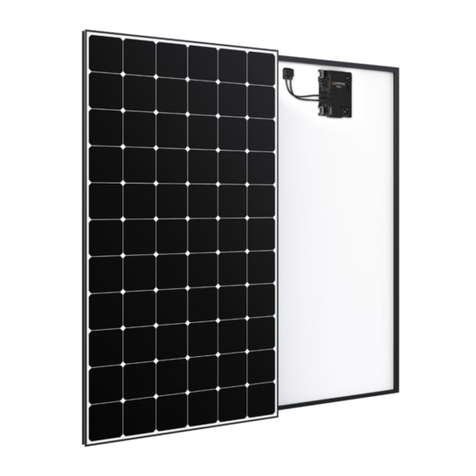
Maxeon
Maxeon SunPower SPR-MAX5-415-E3-AC Safety and installation instructions
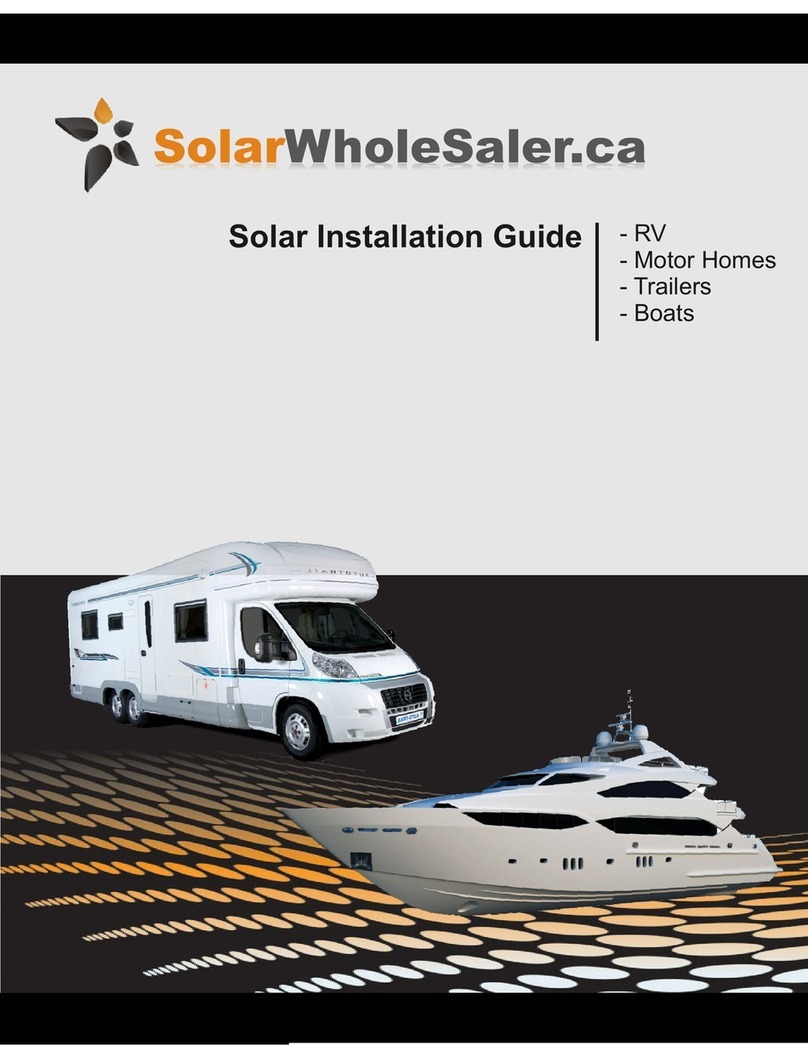
solarwholesaler
solarwholesaler RV installation guide

Thermo King
Thermo King Ingersoll Rand ThermoLite EMEA 36W Installation
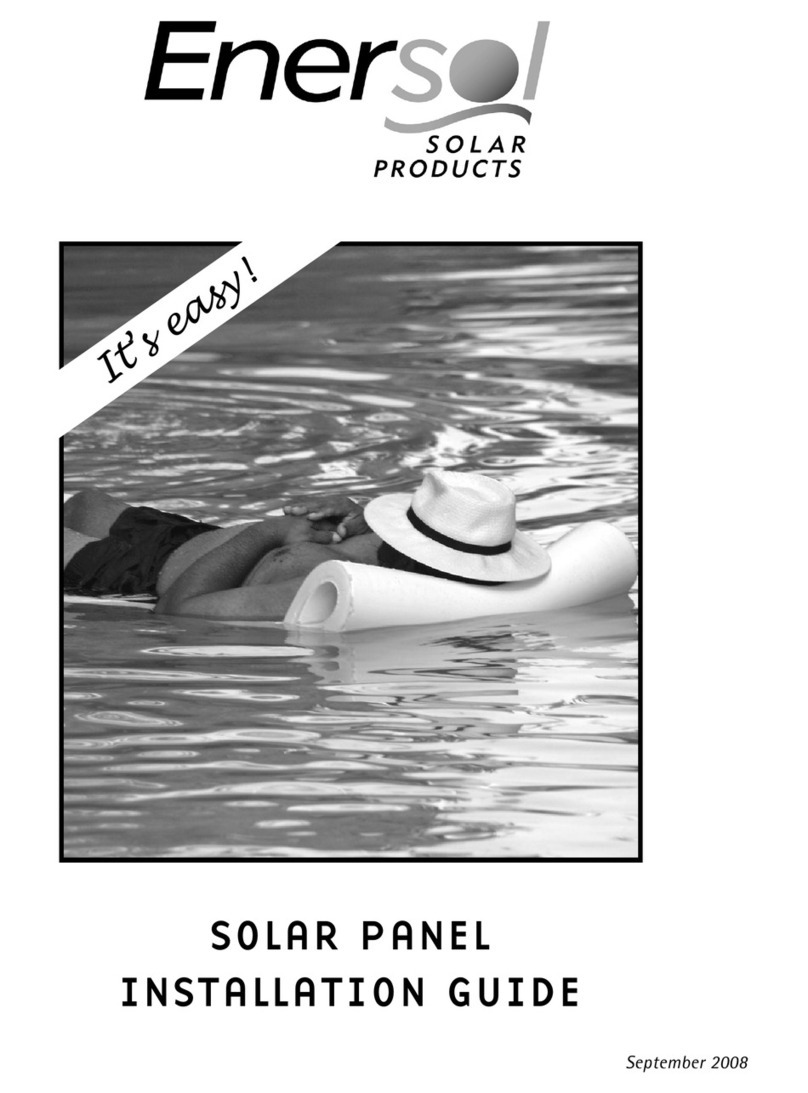
Enersol
Enersol Solar Panel installation guide
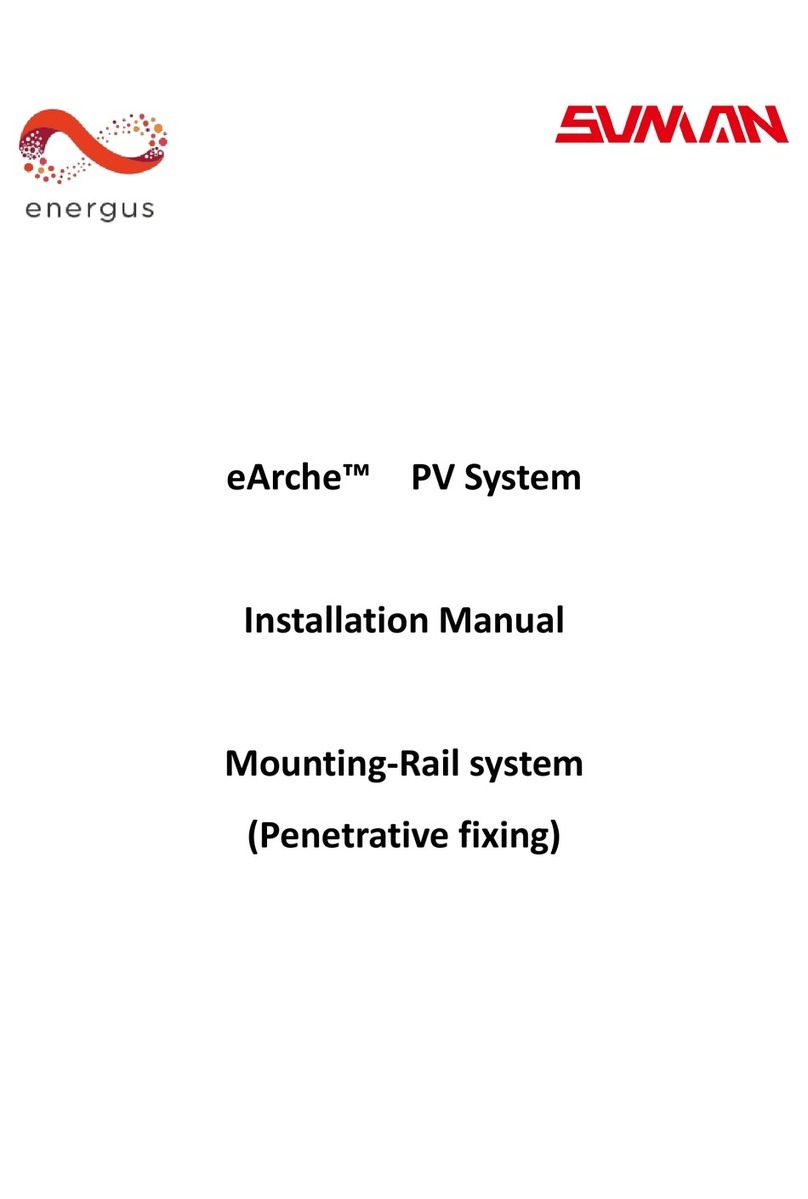
Sunman
Sunman eArche installation manual
